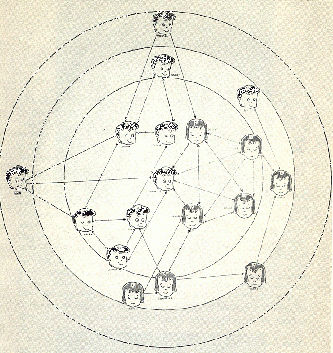User:Lidia.Pereira/GRS/SG: Difference between revisions
No edit summary |
No edit summary |
||
| Line 19: | Line 19: | ||
In the late 1930's, Jacob Levy Moreno, psychologist and the founder of sociometry, accomplished quite a successful intervention at the New York State Training School for Girls Hudson, whose drop out rate was way above average. Diagnosing the problem as one embedded in the existing network of social relationships between the girls, he conducted a simple survey to help him "map the network" - thus creating a sociogram. By studying the girls answers (e.g.: "Who do you want to sit next to?") and juxtaposing them to the current dormitory arrangements, he was able to avoid conflicts by re-allocating them. This proved effective in diminishing the runaway rate. By re-engineering their social relationships, Moreno was able to create a better functioning, more productive network. | In the late 1930's, Jacob Levy Moreno, psychologist and the founder of sociometry, accomplished quite a successful intervention at the New York State Training School for Girls Hudson, whose drop out rate was way above average. Diagnosing the problem as one embedded in the existing network of social relationships between the girls, he conducted a simple survey to help him "map the network" - thus creating a sociogram. By studying the girls answers (e.g.: "Who do you want to sit next to?") and juxtaposing them to the current dormitory arrangements, he was able to avoid conflicts by re-allocating them. This proved effective in diminishing the runaway rate. By re-engineering their social relationships, Moreno was able to create a better functioning, more productive network. | ||
<h3>Social Engineering</h3> | |||
In 1941, the act of social engineering was described by Moreno as one that removes the establishment of social networks more and more from human control. Indeed, the oficial definition of the term social engineering describes it as "a discipline in social science that refers to efforts to influence popular attitudes and social behaviors as a large scale, whether by governments, media, or private groups." | |||
It is interesting to note the utilitarian connection of social engineering to the Taylorist system, also known as the scientific organization of labor, whose purpose is one of improving economic efficiency by the application of positive scientific laws to the analysis and implementation of workflows. Taylorism enjoyed widespread acceptance in the early stages of the Soviet Union, namely by Vladimir Lenin and Leon Trotsky. Alexei Gastev, the founder of the Central Institute of Labour whose work most contributed to the spreading of taylorist ideals, believed that revolution could only be recognized as such if the workers were empowered to control the work processes. ''(more to come)'' | |||
'' | '' | ||
Revision as of 14:40, 24 September 2014
Sociogram
What is it?
The sociogram is a graphical representation of social relantionships in the terms of nodes and links, where every node represents a person and every link represents a relationship.
Merriam-Webster Dictionary:
History
In the late 1930's, Jacob Levy Moreno, psychologist and the founder of sociometry, accomplished quite a successful intervention at the New York State Training School for Girls Hudson, whose drop out rate was way above average. Diagnosing the problem as one embedded in the existing network of social relationships between the girls, he conducted a simple survey to help him "map the network" - thus creating a sociogram. By studying the girls answers (e.g.: "Who do you want to sit next to?") and juxtaposing them to the current dormitory arrangements, he was able to avoid conflicts by re-allocating them. This proved effective in diminishing the runaway rate. By re-engineering their social relationships, Moreno was able to create a better functioning, more productive network.
Social Engineering
In 1941, the act of social engineering was described by Moreno as one that removes the establishment of social networks more and more from human control. Indeed, the oficial definition of the term social engineering describes it as "a discipline in social science that refers to efforts to influence popular attitudes and social behaviors as a large scale, whether by governments, media, or private groups." It is interesting to note the utilitarian connection of social engineering to the Taylorist system, also known as the scientific organization of labor, whose purpose is one of improving economic efficiency by the application of positive scientific laws to the analysis and implementation of workflows. Taylorism enjoyed widespread acceptance in the early stages of the Soviet Union, namely by Vladimir Lenin and Leon Trotsky. Alexei Gastev, the founder of the Central Institute of Labour whose work most contributed to the spreading of taylorist ideals, believed that revolution could only be recognized as such if the workers were empowered to control the work processes. (more to come)
Outline:
- Social Engineering as enforcing the positive science model (ideological extension of self-regulatory economy)
- The abstraction of the social graph + Facebook API
- The abstraction of the database and objectification of the designed subject



